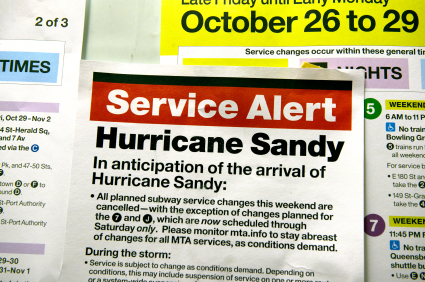 |
As Hurricane Sandy made its way up the East Coast last week, millions in the New York metro area felt the wrath of what was dubbed a superstorm.
With the aftermath of the storm creating massive power outage and leaving trails of damaged homes, many businesses were faced with having to come up with contingency plans for its employees to be able to function and get work done.
For many PR pros who rely on effective communications to do their day-to-day jobs, the approach and strategies of many agencies in the New York-New Jersey area had to be altered as a result of the storm.
Carreen Winters, executive vice president of the MWW Group, based in East Rutherford, N.J., said an event the magnitude of Hurricane Sandy requires creativity because there is no one-size-fits-all approach. With many employees in the Tri-State area without power, cell service or both, MWW used a multichannel approach to keep communications open and connections maintained.
“Electronic communications like e-mail, for those who have access, are being used for broad dissemination of company-wide information—status of office closures and the like,” Winters said. “We are also sharing this information via social media channels like Twitter, Facebook and Yammer, as well as via broadcast text.
“Our first priority was to ensure that all of our employees were safe and accounted for, so our leaders relied on the good, old-fashioned method of calling home phone numbers for anyone we couldn’t reach electronically. That process provided us with the ability to customize their ongoing communications on an individual basis, to be sure we reach people in the manner that is available to them—whether via social media, e-mail, text or a direct phone call.”
Similarly at Global Strategy Group, their primary means of communication has been person-to-person contact via phone, combined with regular team-wide e-mail correspondence, according to Alan Sexton, executive vice president, communications. GSG’s CEO Jon Silvan personally reached out to every member of the Manhattan staff, and the leadership team has held daily coordination calls. Twitter and Facebook played important roles, enabling the agency to check in on people’s safety and status, and were also used as a means of direct communication (particularly as cell phone networks have been overloaded).
It’s impossible to predict how much a natural disaster will affect a community and those who work in it. But having an effective plan of action in place for your company and employees can ease the stress caused by aftereffects of an extreme weather event.
Winters offered the following four tips for companies to follow when the next storm comes along:
- Technology is helpful, but you need to have backups of your backups: A printed copy of home telephone numbers can be the only way to reach people when power and Internet outages are widespread.
- Be proactive about staffing and business continuity plans before an event hits: While it is more convenient to have a team meeting in one office, geographic diversity on the team can be extremely helpful when weather events impact operations locally.
- Hire creative people with a “can do” attitude: "I had an employee checking in with me this week from a supermarket, the only place near her Jersey Shore town that had Internet access," says Winters. "She tapped into their WiFi to send me an e-mail, said that she was OK and asked for help in completing client work."
- Storm-related media pitches should always be pursued with caution—be sensitive and in good taste: When in doubt, don’t do it. It is your job as counselors to tell clients when to proceed and when to stand down. In an event like this storm, there are companies and brands that damage their reputations with an ill-conceived publicity idea. These misjudgments also reflect poorly on the PR profession. Experienced, senior people should always be the final arbiters of any of those ideas before they move forward.
Follow Jamar Hudson: @jamarhudson

Preemptive flooding: If you know that a flooding event is coming, fill the affected area with fresh water. It will be easier to clean, and keeps out sewage and debris.
Emergency electricity: If you own a hybrid car, get an inverter that runs directly from your high voltage battery. The engine will start and stop automatically to maintain the charge, using a minimum of gas — and it doesn’t have to be refueled from a small can in the dark.
See steverose dot com.
Geographic diversity is helpful, and the people NOT in the target zone must set their watches to that zone and time their activities accordingly.